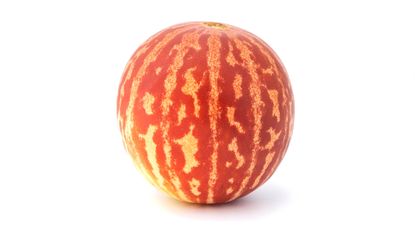Tigger Melon Heirloom Plants


I must confess to being a fan of cucurbits. Melons, squash and gourds come in such a variety of sizes, shapes, textures and colors; they capture the imagination and engage the eye. Tigger melon (Cucumis melo) is one of the prettiest, with a slightly psychedelic appearance reminiscent of tie-dyed fabric. The starburst patterns and orange mottling is especially appealing to me, so I'm fairly confident that you will enjoy this melon too. The flavor is not to be back-seated either. It is aromatic, just sweet enough, and has a tender, juicy white flesh.
Tigger Melon Information
This heirloom melon is a wild plant that grows in Africa and other warm season regions. More than 4,000 years ago, Egyptians saved seeds and cultivated their favorites. The sweetest seeds were saved to produce more palatable fruits. Over time, through trade and exploration, these melon seeds were brought to other regions and found wide acceptance. By the late 1800's, seed production and hybridization was in its heyday. Seed trade and saving was a common practice, and heirloom varieties were big prizes up until the commercial agricultural laws of the 1960's and 70's. If you have never heard of Tigger melon, don't be dismayed. You're not alone. This Armenian melon just sort of happened in an open-pollinated field. Upon discovery of the plant, it was deemed good, and seeds were saved for successive crops. Baker Creek Heirloom seeds first brought the melon into the spotlight. Now you can get seeds online anywhere and try growing Tigger melons yourself. They are small melons, only about one pound, and practically a single serving. Once you cut open the variegated orange and yellow rind, the flesh is cream colored and has a rich melon flavor. From all accounts, the perfume of the flesh will fill an entire room. I can smell it now.
Growing Tigger Melons
A sad piece of Tigger melon information is that it is not something we can all grow. That is because it requires 85 days to harvest, a growing span that some of us in northern and temperate climes just don't have. Nonetheless, it helps to know how to grow melons like this. Make hills in rich soil and plant 2 to 3 seeds per hill, ½ inch deep. You have to wait until the soil is at least 70 degrees Fahrenheit (21 C.) for the best chance of germination. All of us who live in short season climates can start them indoors 6 to 8 weeks before the date of the last frost and might get a fruit or two after planting them out. One can only hope anyway. Warm season gardeners will get pounds of the fruit per vine as long as they apply plenty of water. Use a liquid fertilizer with a 2-1-1 ratio on seedlings. Harvest the melons when a slight tug severs the fruit from the vine. You can keep the baseball sized fruit in the refrigerator for up to 2 weeks.
Gardening tips, videos, info and more delivered right to your inbox!
Sign up for the Gardening Know How newsletter today and receive a free download of our most popular eBook "How to Grow Delicious Tomatoes."
-
 Want a Backyard Mini Orchard? Create Your Own Container Orchard
Want a Backyard Mini Orchard? Create Your Own Container OrchardEasier to care for in small spaces, a backyard mini-orchard makes sense for busy gardeners and juicy fruit is the reward.
By Teo Spengler
-
 Urban Beekeeping Guide: Top Tips For Raising Bees In The City
Urban Beekeeping Guide: Top Tips For Raising Bees In The CityUrban beekeeping can be a rewarding and appreciated pastime, but first be sure it’s legal in your city and learn the ropes of beekeeping.
By Mary Ellen Ellis